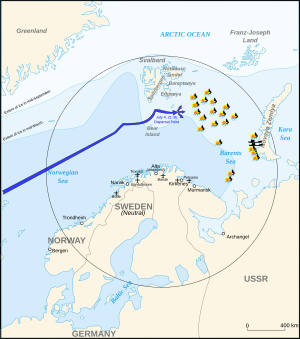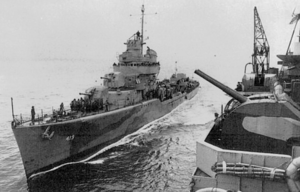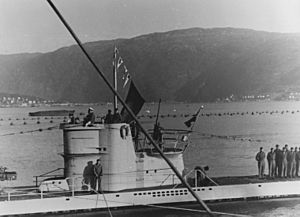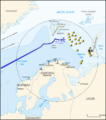Convoy PQ 17 facts for kids
Quick facts for kids Convoy PQ 17 |
|||||||
|---|---|---|---|---|---|---|---|
| Part of Second World War, Arctic Campaign | |||||||
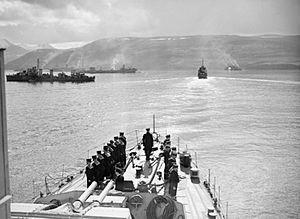 Escorts and merchant ships at Hvalfjord May 1942 before the sailing of Convoy PQ 17. |
|||||||
|
|||||||
| Belligerents | |||||||
| Commanders and leaders | |||||||
| Strength | |||||||
| 35 merchant ships Close escort: 6 destroyers, 11 escort vessels, 2 anti-aircraft ships, Covering forces: 1 aircraft carrier, 2 battleships, 6 cruisers, 13 destroyers (did not engage): |
1 battleship, 3 cruisers, 12 destroyers (did not engage): 11 U-boats: 33 torpedo aircraft, 6 bombers. (Flying over 200 sorties) |
||||||
| Casualties and losses | |||||||
| 24 merchant ships sunk, 153 merchant mariners killed |
5 aircraft | ||||||
Convoy PQ 17 was a group of Allied ships sailing together for safety during the Second World War. These ships were part of the Arctic convoys, which delivered important supplies to the Soviet Union from Britain and the United States. On June 27, 1942, Convoy PQ 17 left Hvalfjörður, Iceland, heading for the port of Arkhangelsk in the Soviet Union.
German forces found the convoy on July 1 and began to follow and attack it. The British naval leader, Admiral Dudley Pound, received information that powerful German warships, including the huge battleship Tirpitz, were planning to attack. Because of this threat, he ordered the Allied warships protecting the convoy to move away. He also told the merchant ships to scatter and try to reach their destination on their own.
However, the Tirpitz never actually attacked. The merchant ships were left without their strong escorts and were then attacked by German planes (the Luftwaffe) and U-boats (submarines). Out of 35 merchant ships, only eleven made it to their destination. This disaster showed how hard it was to send supplies through the Arctic, especially during the summer when the sun never sets (the midnight sun). German success was partly due to their ability to intercept and understand Allied secret messages.
Contents
Why the Convoys Started
When Germany started its war against the Soviet Union in June 1941, Britain and the United States agreed to send aid to their new ally. They decided to send military supplies and other goods. The fastest way to deliver these supplies was by sea, sailing around the North Cape through the cold Arctic waters to the Soviet ports of Murmansk and Arkhangelsk.
At first, the Soviet Union was supposed to use its own ships. But they didn't have enough, so British and American ships started carrying more and more of the supplies. The British Royal Navy was in charge of protecting these Arctic convoys. However, the American Navy also sent ships to help, including the battleship USS Washington.
The first convoy sailed in August 1941. By spring 1942, twelve more convoys had made the trip, with very few losses. But then, the Germans started to focus more on stopping these convoys. They moved powerful warships, like the battleship Tirpitz and heavy cruisers, to bases in Norway. This made the journey much more dangerous for the Allied ships.
British Plans for Protection
British intelligence learned in June 1942 that Germany planned to use its big warships to attack the next convoy, PQ 17. This plan was called Operation Rösselsprung (Operation Horse Jump). The German ships would operate close to the Norwegian coast, where they could get support from planes and submarines.
The Allied warships, however, would be far from their bases and wouldn't have air support. To deal with this, the British Admiralty (the Royal Navy's command center) gave special instructions. They said the convoy could turn back if needed to stay closer to Allied bases. They also decided that the main cruiser force protecting the convoy should not go too far east, past a certain point, unless a major German surface force was threatening the convoy.
A fake convoy was also set up to trick the Germans. This group of ships sailed a few days after PQ 17, hoping to draw German attention away. However, the Germans didn't notice this fake convoy. Another convoy, QP 13, was sailing west from Russia at the same time. The Germans saw it but didn't attack, as they preferred to target the eastbound convoys carrying supplies.
As the convoy sailed, new information about the ice showed that a wider path north of Bear Island was open. The British suggested the convoy should take this more northerly route.
Protecting the Convoy
Convoy PQ 17 had several layers of protection. The "close escort" stayed right with the merchant ships. This group included destroyers, corvettes, minesweepers, and anti-aircraft ships.
Further away, there was a "cruiser covering force" with British and American cruisers and destroyers. Even further back, the main "heavy covering force" included the aircraft carrier HMS Victorious, the battleship Duke of York, and the American battleship Washington, along with more cruisers and destroyers. These powerful ships were meant to stop any major German warships.
The covering forces moved into position as the convoy sailed. They were spotted by German forces a few times. British intelligence also reported that German heavy ships, including Tirpitz, were likely moving north from Trondheim. Because of this, the Allied commanders decided the cruiser squadron should stay close to the convoy, even east of Bear Island.
German Forces Ready to Attack
Germany's navy, the Kriegsmarine, gathered a large force to attack Convoy PQ 17. They had a group of 11 U-boats (submarines) called Eisteufel (Ice Devil) waiting to intercept the convoy. They also had two powerful groups of surface ships in Norwegian ports. These included the battleship Tirpitz and the cruisers Hipper, Scheer, and Lützow, along with twelve destroyers.
This was the strongest force Germany had ever put together for a convoy attack. However, their command structure was complicated. The final decision to attack rested with Adolf Hitler, and the German ships were told to destroy the convoy but also to avoid any damage to their own capital ships, especially Tirpitz. German planes from Luftflotte 5 also supported these forces, with about 243 aircraft based in northern Norway.
The Convoy's Journey and First Attacks
Convoy PQ 17 left Iceland on June 27 with 34 merchant ships, an oiler, and three rescue ships. One ship had to turn back due to mechanical problems, and another due to ice damage.
The convoy was soon spotted by a German U-boat, U-456, and was tracked almost constantly. German flying boats also began to follow the convoy. On July 2, PQ 17 saw another convoy, QP 13, sailing in the opposite direction. Later that day, PQ 17 faced its first air attack by nine torpedo planes, but they missed, and one German plane was shot down.
On the morning of July 4, a German plane hit the American merchant ship SS Christopher Newport. A British submarine tried to sink her to prevent capture, but she stayed afloat. Finally, the German submarine German submarine U-457 sank the ship. Later that evening, 25 torpedo bombers attacked, sinking another American ship, SS William Hooper. The American destroyer USS Wainwright helped break up one of these air attacks.
The Order to Scatter
| Time | From | To | Message |
|---|---|---|---|
| 21:11 | ADMY | CS1 | Cruiser Force withdraw to the westward at high speed. |
| 21:23 | ADMY | CS1 | Owing to threat from surface ships, convoy is to disperse and proceed to Russian ports. |
| 21:36 | ADMY | CS1 | Convoy is to scatter. |
On July 4, the British Admiralty sent a series of urgent messages. They first told the cruiser force to pull back quickly. Then, they ordered the convoy to "disperse" and head for Russian ports on their own because of a threat from German surface ships. Finally, they sent a "Most Immediate" message, ordering the convoy to "scatter."
The commanders of the convoy and its escorts believed these messages meant the Tirpitz was about to attack. So, the convoy was immediately ordered to scatter. The escorting destroyers were told to join the cruisers, leaving the merchant ships to sail alone.
What the Allied commanders didn't know was that the Tirpitz and its battle group were not actually heading towards the convoy. The Tirpitz had moved to a different fjord in Norway and was not at sea to attack. The German operation by surface ships was cancelled on July 5, and the ships returned to port. The decision to scatter the convoy, based on incorrect information, proved to be a terrible mistake.
Heavy Losses for the Convoy
When the order to scatter was given, the convoy had completed more than half its journey. But now, the ships were spread out over a huge area, without any protection from their escorts. The larger escort ships were ordered to return to base, leaving only smaller vessels like corvettes and minesweepers to protect the scattered ships.
Messages from the merchant ships started coming in: "Being bombed by a large number of planes," "On fire in the ice," "Abandoning ship," "Six U-boats approaching on the surface."
On July 5, six merchant ships were sunk by German planes, and six more by U-boats. More ships were lost in the following days. By July 10, the last losses occurred. The German Luftwaffe flew over 200 attacks and only lost five planes, while sinking eight merchant ships.
One British anti-submarine trawler, HMS Ayrshire, decided not to head for Arkhangelsk. Instead, its commander, Lieutenant Leo Gradwell, led his small group of ships north into the Arctic ice. They stopped their engines, covered their decks with white paint and linen, and even arranged Sherman tanks on the merchant ships' decks for defense. After waiting and avoiding German planes, they eventually reached safety and were escorted to Arkhangelsk on July 25.
Some ships and lifeboats took refuge along the frozen coast of Novaya Zemlya. After a long search, the full extent of the disaster became clear. Of the 34 ships that left Iceland, 23 were sunk. Only eleven ships reached Russian ports. This meant that only about 70,000 tons of supplies arrived, out of the 200,000 tons that had started from Iceland.
Aftermath and Impact
The British Prime Minister, Winston Churchill, called the loss of Convoy PQ 17 "one of the most melancholy naval episodes in the whole of the war." An investigation was held, but no one was officially blamed.
The Soviet Union found it hard to believe so many ships could be lost. They openly accused the Western Allies of lying. Joseph Stalin and Soviet naval experts couldn't understand why the escorting ships would leave the convoy and tell the cargo ships to scatter without protection. The American Admiral Ernest King was very angry and pulled his ships out of joint operations under British command, sending them to the Pacific.
Because of the disaster, the British Admiralty decided to stop the Arctic convoys for a while. German Admiral Erich Raeder even claimed that their submarines and aircraft had forced the enemy to give up this route. The Soviets, however, pushed for the convoys to restart.
It wasn't until September that Convoy PQ 18 sailed for North Russia. This time, the convoy had a much stronger escort, including sixteen destroyers and the first of the new escort carriers, HMS Avenger, which carried fighter planes and anti-submarine aircraft.
Many merchant navy officers and men were honored for their bravery during Convoy PQ 17. In 2012, the Arctic Star medal was created, and the first medals were given to veterans in 2013.
Images for kids


